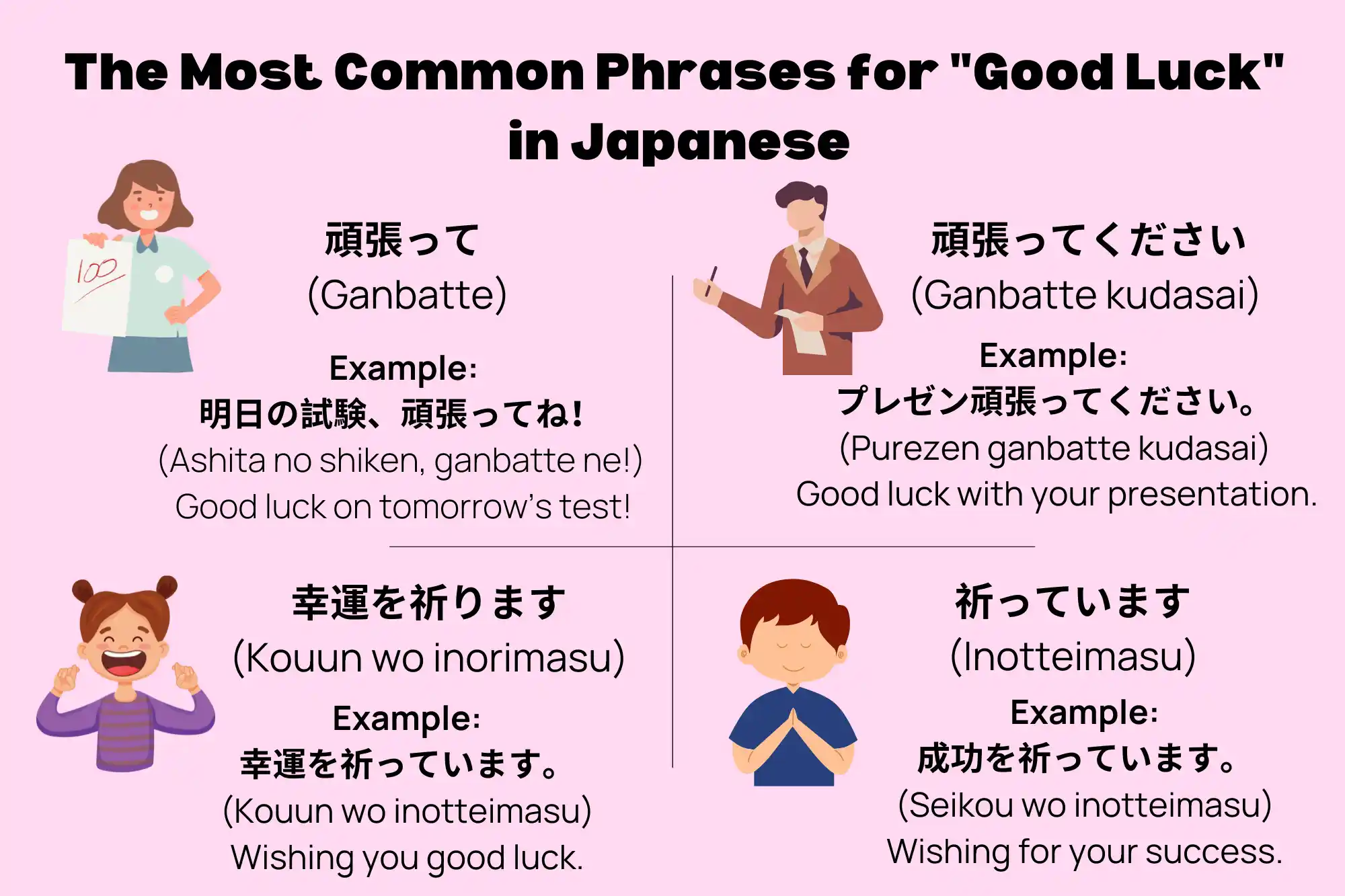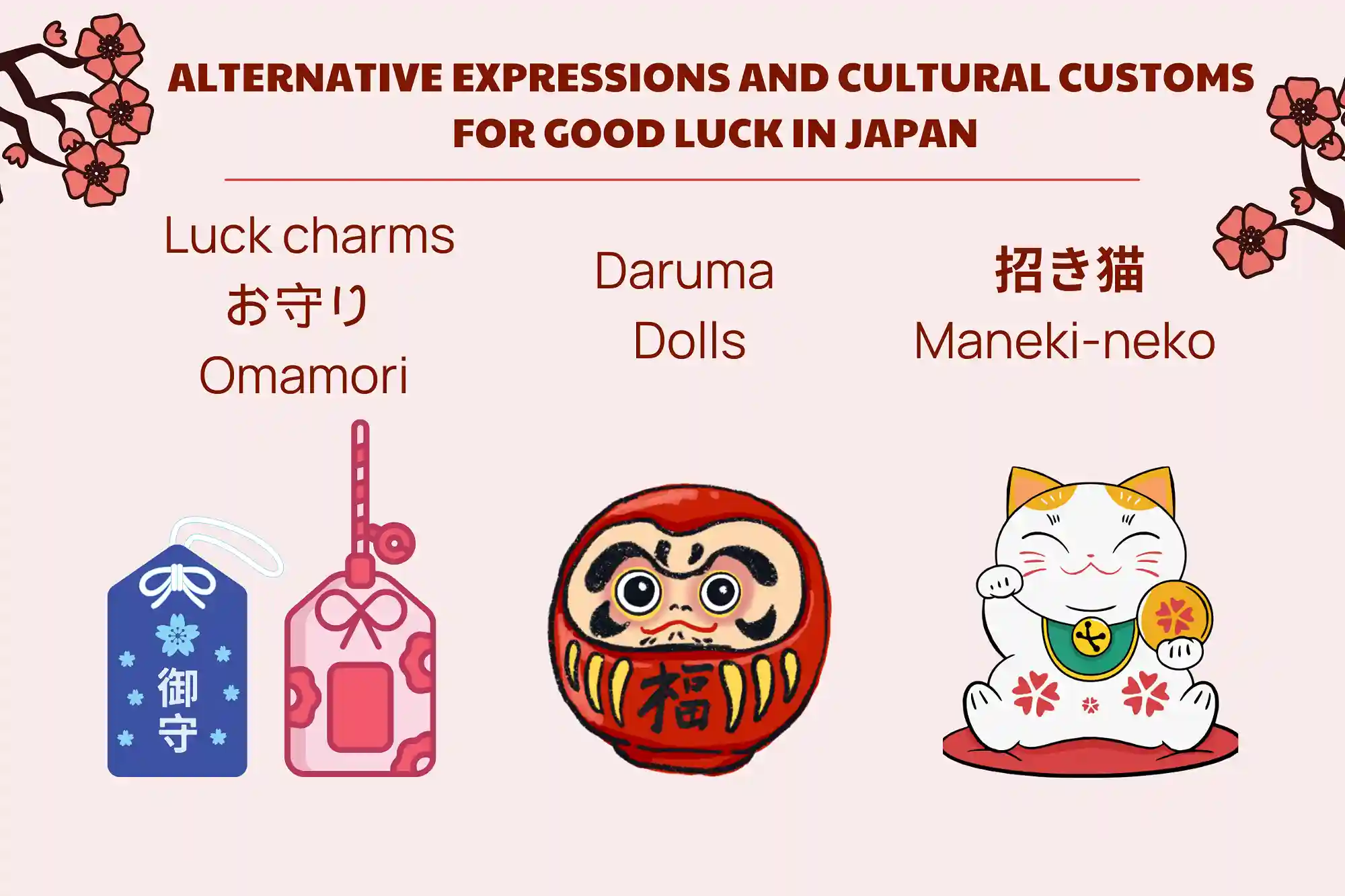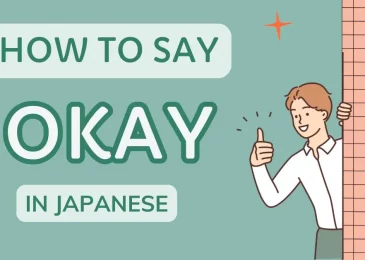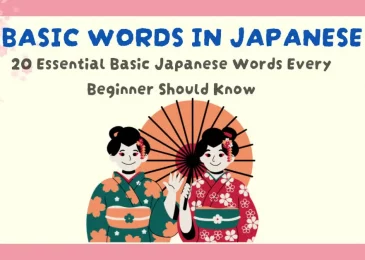Wishing someone “good luck” can be a wonderful way to show support and encouragement. In Japan, the concept of “good luck” holds deep cultural and social significance, and there are several ways to convey it depending on the situation. This guide will introduce you to various ways of saying “good luck” in Japanese, along with cultural insights and pronunciation tips to help you express good wishes with authenticity.
What does “Good luck” mean in Japanese culture?
In Japanese culture, the concept of “good luck” or “fortune” is deeply connected to spiritual and social customs. This value of fortune is rooted in Japan’s spiritual traditions, such as Shintoism and Buddhism, where blessings, protection, and luck are closely tied to everyday life. From auspicious events like exams and new job ventures to life changes like moving or marriage, luck is often considered a supportive force that can influence one’s path.
To wish someone good luck, people in Japan frequently turn to a mix of common phrases, symbolic items, and gestures that show encouragement. Expressions for “good luck” may also vary in tone and formality, allowing them to fit different relationships and settings.
The most common phrases for “Good luck” in Japanese
Here are some widely-used Japanese phrases that mean “good luck,” each suited to specific situations:

1. 頑張って (Ganbatte)
One of the most versatile and widely-used phrases for offering encouragement in Japanese, 頑張って (ganbatte) translates to “do your best” or “hang in there!” This expression is a friendly and informal way to boost someone’s spirits, often used when people are facing tasks that require determination or effort. Whether it’s an upcoming exam, a sports competition, a musical performance, or a job interview, “ganbatte” is a way to show support and inspire confidence. Its uplifting tone conveys a sense of camaraderie, as if you’re cheering on the person to give it their all.
This phrase is commonly used among friends, family, or peers, and it’s a great go-to for everyday situations. Saying “ganbatte” acknowledges the effort that will be needed and expresses belief in the person’s abilities to overcome the challenge.
Example:
“明日の試験、頑張ってね!” (Ashita no shiken, ganbatte ne!) – “Good luck on tomorrow’s test!”
2. 頑張ってください (Ganbatte kudasai)
When a more respectful tone is needed, 頑張ってください (ganbatte kudasai) is a polite variation of 頑張って. By adding ください (kudasai), which means “please,” this phrase becomes formal and appropriate for wishing “good luck” in professional or respectful settings. This could include situations where you are addressing teachers, managers, or colleagues, especially if you aren’t very close to them or if you wish to show extra politeness.
Using “ganbatte kudasai” maintains the motivational spirit of the original phrase while softening it to fit a more courteous context. It’s a thoughtful way to show that you’re rooting for their success without being overly casual.
Example:
“プレゼン頑張ってください。” (Purezen ganbatte kudasai) – “Good luck with your presentation.”
3. 幸運を祈ります (Kouun wo inorimasu)
The phrase 幸運を祈ります (kouun wo inorimasu) offers a more formal way to say “I wish you good fortune.” Here, 幸運 (kouun) means “good luck” or “good fortune,” and 祈ります (inorimasu) means “to pray.” This phrase is ideal when you want to convey sincere wishes for success, especially in written messages, letters, or formal conversations. Because it sounds respectful and thoughtful, it’s often used when people are embarking on new journeys, such as starting a new job or moving to a new place.
Unlike “ganbatte,” which emphasizes effort, “kouun wo inorimasu” centers on wishing favorable outcomes. It’s a wonderful way to wish someone well without implying that the outcome depends solely on their hard work, making it suitable for circumstances where chance plays a role.
Example:
“幸運を祈っています。” (Kouun wo inotteimasu) – “Wishing you good luck.”
4. 祈っています (Inotteimasu)
The phrase 祈っています (inotteimasu) comes from the verb 祈る (inoru), which means “to pray.” It’s used to express genuine hopes or prayers for a positive result. This phrase is particularly suitable for situations with uncertain or unpredictable outcomes, such as when someone is undergoing surgery, waiting for important news, or preparing for a critical moment in life.
When you say “inotteimasu,” you’re offering support through a wish or prayer for success rather than emphasizing the individual’s effort. This phrase can be very comforting, especially in sensitive situations, as it implies that you are thinking of them and hoping for the best on their behalf.
Example:
“成功を祈っています。” (Seikou wo inotteimasu) – “Wishing for your success.”
Each of these expressions carries its own tone and nuance, making it possible to choose a phrase that best matches the situation and your relationship with the person you’re addressing. Understanding these variations allows you to show support in a way that aligns with Japanese language and cultural sensitivities.
To expand your vocabulary for “good luck,” consider the MochiKanji app, which offers a variety of courses for different levels, from N5 to N2, ensuring learners can progress at their own pace. Each course is designed to build a deep understanding of vocabulary, grammar, and culture, providing a well-rounded learning experience.

A standout feature is the Golden Time function, which is based on spaced repetition, sends notifications, and includes a countdown timer to help you review vocabulary effectively. For those looking to improve their conversational skills, MochiKanji features interactive dialogues that help you practice basic Japanese conversation with the characters Mochi and Michi.
Using these comprehensive tools, you can easily integrate “good luck” phrases and other expressions into your everyday conversations, enriching your communication and connection with the language.
Using “Good luck” in Japanese for different situations
Japanese language and culture emphasize context, so here are some ways to adapt “good luck” phrases to different situations:
- Exams and Studies: Use “頑張って” to encourage someone preparing for exams or working hard at school. It’s casual and commonly used among friends and classmates.
Example: “テスト頑張ってね!” (Tesuto ganbatte ne!) – “Good luck with your test!” - Sports and Competitions: For athletic events, “頑張って” can energize and support the athlete’s efforts. Its upbeat tone conveys confidence.
Example: “試合、頑張ってください!” (Shiai, ganbatte kudasai!) – “Good luck with the match!” - New Ventures or Travels: When someone is starting a new chapter or embarking on a trip, people may add “気をつけて” (Ki o tsukete), which means “take care,” to “ganbatte.”
Example: “新しい仕事で頑張って!” (Atarashii shigoto de ganbatte!) – “Good luck with your new job!”
Alternative expressions and cultural customs for good luck in Japan
Japan has a rich cultural heritage filled with unique ways to wish someone good luck, often through symbolic gestures and items that carry a special meaning. Instead of merely saying “good luck,” the Japanese often use these traditional items to convey support, encouragement, and positive wishes, especially during important milestones in a person’s life. Here are some of the most popular and meaningful alternatives:

1. Luck charms (お守り / Omamori)
Omamori are small, colorful pouches typically purchased at Shinto shrines or Buddhist temples across Japan. These charm bags are believed to offer protection and bring good fortune to the owner. Each omamori is dedicated to a specific type of luck or protection, such as success in exams, safety in travel, good health, or even romantic success. For instance, students might receive an omamori for academic achievement, while travelers may carry one for safe journeys. Giving an omamori as a gift is a thoughtful way to express good wishes for a loved one’s well-being, and it’s a deeply meaningful gesture in Japanese culture.
2. Daruma Dolls
Daruma dolls are iconic symbols of perseverance, good luck, and personal goals in Japan. These round, hollow dolls are typically painted in vibrant red and have a unique design: they come with blank eyes. When setting a personal goal or wishing for success, the owner colors in one eye of the Daruma doll as a commitment to achieving their aspiration. When the goal is achieved, they color in the other eye to signify completion. This ritual makes Daruma dolls popular gifts for New Year celebrations, new job ventures, and other important life changes, symbolizing the resilience and determination needed to reach one’s dreams.
3. Maneki-neko (招き猫)
The maneki-neko, or “beckoning cat,” is a famous figurine in Japan known for attracting good fortune. Often seen in homes, stores, and restaurants, this cat statue has one paw raised in a beckoning gesture, which is believed to bring in prosperity and good luck. The maneki-neko is available in various colors, with each color representing different types of luck. For example, a gold maneki-neko is believed to attract wealth, while a pink one is thought to bring success in love. The maneki-neko is a common sight in Japanese businesses and homes, symbolizing a warm invitation for good things to come.
4. Other good luck symbols in Japan
In addition to omamori, Daruma dolls, and maneki-neko, Japanese culture has other objects and rituals associated with good luck. For instance, bamboo, known as “sasa,” is considered a lucky plant, symbolizing strength and growth, and is sometimes gifted for new beginnings. “Ema” plaques, wooden tablets on which people write their wishes, are also commonly left at shrines, with hopes that the gods will grant their prayers.
Using or gifting these items goes beyond words and is a meaningful way to wish someone “good luck” in Japanese culture. Each item is filled with symbolism and intention, allowing people to show their support and encouragement in a thoughtful and culturally respectful manner.
When not to use “Good luck” phrases in Japanese
While “good luck” phrases in Japanese are generally positive and supportive, certain situations require different expressions to avoid seeming insensitive or inappropriate. In Japanese culture, understanding the emotional context is essential for showing respect, so it’s important to be aware of when these phrases may not be suitable. Here are some instances where wishing someone “good luck” might not be appropriate:
1. Illness or serious hardships
Saying “頑張って” (ganbatte) to someone facing serious health issues or going through a challenging period, like an illness or personal hardship, can feel out of place or even pressuring. Since “ganbatte” implies encouragement to keep pushing forward, it may unintentionally suggest that the person needs to work harder, which can be insensitive in difficult or exhausting situations. Instead, a gentler expression such as “お大事に” (odaiji ni), meaning “take care of yourself,” may be more comforting. This phrase shows genuine concern for the person’s well-being without adding any pressure, allowing you to convey compassion and care.
2. Situations of grief or loss
During times of mourning, loss, or other forms of emotional distress, using phrases that wish someone “good luck” can feel dismissive or overly casual. In these situations, people are often looking for comfort, support, or simply understanding, rather than encouragement to “do their best.” Offering sympathetic words, a gentle presence, or even respectful silence can be much more appropriate than typical encouragement phrases. Japanese culture values subtlety and sensitivity, so showing respect in these ways allows for a more compassionate response.
Being mindful of these moments, and adapting your language to suit the emotional tone, shows a deep respect for Japanese customs and demonstrates empathy. Taking time to choose the right words for each unique situation is a significant part of showing understanding and cultural sensitivity.
Tips for pronouncing “Good luck” phrases correctly in Japanese
To make your “good luck” wishes sound natural in Japanese, here are some pronunciation tips:
- Emphasize the Correct Syllables: In Japanese, intonation affects meaning, so place emphasis on the right syllables. For “頑張って” (ganbatte), stress the “gan-BAT-te” to make it sound encouraging.
- Pronounce Each Syllable Clearly: Japanese syllables are shorter and more staccato than in English. Practice saying each sound crisply: “GA-n-BA-tte.”
- Use Appropriate Politeness Levels: Depending on whom you’re speaking to, adjust your language formality. For instance, add “kudasai” to make “ganbatte” polite.
Frequently asked questions about “Good luck” in Japanese
1. What does “good luck” mean in Japanese culture?

In Japan, the concept of “good luck” holds deep cultural and spiritual significance, often connected to both religious beliefs and life milestones. Wishing someone “good luck” not only expresses support and encouragement but also acknowledges the challenges they might be facing. Rather than relying solely on words, Japanese culture often emphasizes physical gestures of support through meaningful items like omamori (good luck charms) or daruma dolls, which symbolize perseverance and positivity. These practices reflect a deep-rooted belief in the power of well-wishes and lucky symbols to bring protection and positive outcomes.
2. Can I use “ganbatte” in formal situations?
Yes, you can use “ganbatte” in formal contexts, but it’s best to use the more polite version: “頑張ってください” (ganbatte kudasai). Adding “kudasai” makes the expression respectful, which is ideal for workplaces or formal events. While “ganbatte” by itself is friendly and informal, “ganbatte kudasai” shows a level of deference suitable for conversations with colleagues, managers, or people of higher status. This way, you’re able to show your support while maintaining cultural and social respect.
3. Are there specific “good luck” phrases for exams?
Yes, “頑張って” (ganbatte) is commonly used as an encouraging phrase specifically for exams and academic efforts. It’s frequently said among friends, classmates, and family members to show support before important tests or assignments. Another supportive phrase you might hear is “ファイト!” (faito), derived from the English word “fight,” which conveys a similar sentiment of “keep going” or “you can do it!” Both phrases are used casually to give a confidence boost before exams or big challenges.
4. What are some alternative ways to wish good luck in Japanese?
Aside from verbal encouragement, Japanese culture offers several traditional items that serve as symbols of good luck. For example, omamori, small charm bags bought at temples and shrines, are commonly given to loved ones for exams, health, and even travel protection. Daruma dolls are another popular choice, symbolizing perseverance and goal-setting, often used as a gift when someone is working toward a significant personal goal. The maneki-neko, or “beckoning cat,” is also widely recognized as a symbol of good fortune, often seen in businesses or homes to bring prosperity. These symbolic items go beyond wor
Conclusion
Saying “good luck” in Japanese is more than just a phrase—it’s a thoughtful gesture rooted in cultural values of encouragement and support. Whether you’re cheering on a friend, encouraging a coworker, or expressing well-wishes to someone you admire, these expressions will help you connect and communicate with respect. Remember, understanding the nuances of each phrase and when to use it appropriately can help you truly embrace the spirit of Japanese language and culture.





